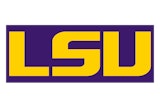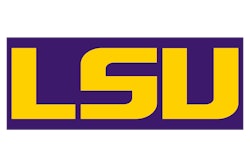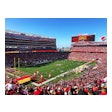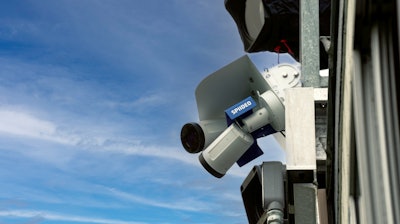
The days of lugging a camcorder out to the sidelines to tape a game or practice have long since passed. Today’s high-tech video and streaming systems are infinitely more sophisticated, and the footage is being used at all levels of sport for everything from coach and player analysis to creating social media content and recruiting videos. Here’s a look at how video is being used at all levels in the world of modern athletics.
 Photos courtesy of Pixellot
Photos courtesy of Pixellot
Set it, forget it
The process of putting together game footage for a high school or college team used to be a laborious one. Staff needed to arrive prior to a practice or game and set up equipment. Additional staff was needed to operate that equipment, ensuring the action was caught in a useful manner, and after the game or practice, all that footage needed to be cut down for efficient viewing by coaches and players.
That’s all changed with today’s systems, which can be permanently installed in venues and automatically set to record during practices and games. Mobile hardware can also be set up in a matter of minutes for away games. Most systems are also run on software platforms that use artificial intelligence to automatically track the action, or even an individual player.
Fredrik Ademar, vice president of product for Spiideo, which makes an automated video sports solution, says customers still want basically the same thing they’ve always wanted — great video — but the process for producing that has now been dramatically streamlined by technology. “Video capture of sports for performance purposes is not new by any means, but it has been historically very inefficient,” Ademar says. “And often the output you got was pretty poor because they were filming the wrong thing. I would say the main thing we’re helping coaches and teams with when it comes to sports performance is really to make sure they always have really good footage from all parts of the pitch, because we always capture the entire pitch from multiple angles.”
Like many providers, Spiideo offers both fixed and mobile solutions, and a feature called AutoFollow uses AI for player-specific tracking. The company’s panoramic cameras cover the entire field, while an analytics platform enables deep analysis of the video after the game or practice. The best part: it’s a set-it-and-forget-it operation — no one needs to be behind the camera.
David Shapiro, president of North America for Pixellot, which also produces a video capture platform for athletics, stresses that automation is the key. “Our core is really producing video without having a human operator,” Shapiro says. “You don’t have to be at a game with a handheld, going back and forth. You set it up, forget about it, and it produces the video, tracks the action, zooms in, zooms out, and also creates automatic highlights for players. It just reduces the time and effort of having somebody produce the video in a high-quality way, and it reduces the time and effort of having somebody cut up the video to get the moments that matter and the moments that you want.”
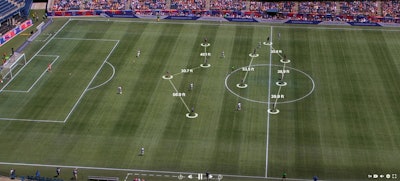 Image courtesy of Pixellot
Image courtesy of Pixellot
Combining footage, data
So, video has been automated. Cool, but so what, right? Not so fast. Putting a computer platform and some fancy hardware at the helm of your club or school’s video department means being able to break down video at a granular level, as well as capturing a lot of data beyond what’s seen in the footage.
“We can do full breakdown of games,” says Shapiro. “Coaches will use that to help player performance and player development. They’re able to go in there and say, ‘I want to see every shot that Jim took, or every assist that Jim had, or every turnover that Jim had.’ And then you can annotate on the screen. You could circle something and say, ‘If you would have gone left here instead of right, you would have been able to make that basket or get around that defender.’ ”
Beyond player-specific analysis, users of both Spiideo and Pixellot are able to see data that, in some instances, might be more valuable than the footage — and the combination of the two is supremely valuable, especially for coaches.
“The video really adds context to the data,” explains Ademar. “So, I can see that I have 25 sprints in this [soccer] match, but you can actually see where those sprints are in the video. So, you have a direct connection, not just a number on a piece of paper. And that’s actually super important because then you understand whether that player is actually taking these high-intensity runs in the right places. Does that player follow the game setup that we created and actually push with these sprints or high-intensity runs at the right time? So, we use the video to create the data, but the data also needs the video to be truly relevant.”
Ben Wifling, a coach with Next Level Soccer Academy in Pennington, N.J., explains how he uses a video capture platform from a company called TraceUp. “TraceUp has a whole suite of analytics,” Wifling says. “You have player highlights, you get defensive highlights, attacking highlights, goals, build-ups, they call them touch chains, which are passing combinations. I can watch a game and relatively quickly provide feedback to players. For me, it’s really helpful to see what’s working, how to design training sessions we have in the coming week and things that we want to work on. Were there things we did last week being incorporated in the game, and are there things that maybe still need more work?”
The available data produced through these platforms — player speed in miles per hour, topology of the field, biometric data, to name a few — is so extensive that Ademar says one of the big challenges is figuring out how to use and make sense of it all. “To some extent, maybe it’s too much data to manage, because it’s so much and usually they have very little time,” explains Ademar. “One of our challenges really is to make sure that we surface relevant data at the right time, so we’re not overwhelming people with data and video.”
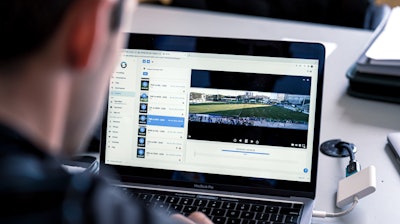
A two-way recruiting tool
The stakes for schools looking to recruit top players at the college level have never been higher, and prep student-athletes always want to put their best foot forward when they’re engaging with prospective colleges and universities. Companies such as Pixellot and Spiideo have taken notice and revolutionized how student-athletes and schools interact.
“Recruiting has shifted to be a lot more digital now than in person, and I think what kind of trained the consumer, both from a parent and athlete perspective, and also the coach perspective, was COVID,” Shapiro says. “During COVID, there was an 18-month period where college coaches were not allowed to go to events. The NCAA also has certain dead periods where even now, after COVID, coaches are not allowed to go and recruit. So, the importance level of video has increased drastically, at least in regards to sorting through kind of the muck of the water. You have so many athletes trying to play, it at least helps coaches narrow down the ones who are worth their time to go and see in person.”
Wifling says many of his players use TraceUp for exactly this purpose. “The older players like to do highlight clips as they get ready for college recruiting, and they’re able to easily aggregate their highlights into one piece.”
Shapiro contends that video puts a kind of power in the players’ hands that just hasn’t been possible in the past. “I think what we’re doing is really democratizing college recruiting. Before you had to travel to the event that the college that you wanted to go to was holding. Now you can have professional video and be able to get that to the colleges that want to see you, at least to start the recruiting process,” he says. “You know, it’s unlikely that a college coach is going to offer a scholarship just based off the video you sent them, but at least now they can see a lot more and determine if you might be of interest to them.”










